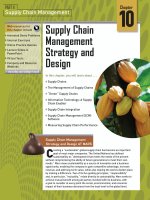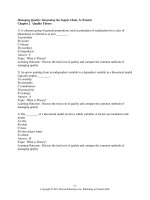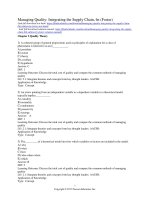Lecture Operations management: Creating value along the supply chain (Canadian edition) - Chapter 2
Bạn đang xem bản rút gọn của tài liệu. Xem và tải ngay bản đầy đủ của tài liệu tại đây (1009.02 KB, 77 trang )
Chapter 2
OPERATIONS MANAGEMENT:
Creating Value Along the Supply Chain,
Canadian Edition
Robert S. Russell, Bernard W. Taylor III, Ignacio Castillo, Navneet Vidyarthi
CHAPTER 2
Quality Management
Learning Objectives
Discuss the meaning of quality of goods and services from both the
producer’s and consumer’s perspectives.
Discuss the evolution of quality management into a quality
management system, including key figures and their contributions.
Use several common quality-control tools.
Describe several approaches used for involving
employees in the quality-improvement process.
Describe the Six Sigma and Lean Six Sigma quality management
systems and calculate changes in profit resulting from Six Sigma
projects.
Classify quality-related costs and calculate and interpret qualitymeasurement indices.
Use several quality measures that reflect productivity.
2-2
Lecture Outline
What Is Quality?
Quality in Service
Evolution of Quality
Companies
Six Sigma
Cost of Quality
Effect of Quality
Management on
Productivity
Quality Awards
ISO 9000
Management
Quality Tools
TQM and QMS
Focus of Quality
Management—Customers
Role of Employees in
Quality Improvement
2-3
What Is Quality?
Oxford American Dictionary
• a degree or level of excellence
American Society for Quality
• totality of features and characteristics that satisfy
needs without deficiencies
Consumer’s and producer’s perspective
2-4
What Is Quality:
Customer’s Perspective
Fitness for use
• how well product or service does what it is supposed to
Quality of design
• designing quality characteristics into a product or service
A Mercedes and a Ford are equally “fit for use,” but with different design
dimensions.
2-5
Dimensions of Quality:
Manufactured Products
Performance
• basic operating characteristics of a product; how
well a car handles or its gas mileage
Features
• “extra” items added to basic features, such as a
stereo CD or a leather interior in a car
Reliability
• probability that a product will operate properly
within an expected time frame; that is, a TV will
work without repair for about seven years
2-6
Dimensions of Quality:
Manufactured Products
Conformance
degree to which a product meets pre–established
standards
Durability
how long product lasts before replacement; with
care, L. L. Bean boots may last a lifetime
Serviceability
ease of getting repairs, speed of repairs, courtesy
and competence of repair person
2-7
Dimensions of Quality:
Manufactured Products
Aesthetics
• how a product looks, feels, sounds, smells, or tastes
Safety
• assurance that customer will not suffer injury or harm
from a product; an especially important consideration
for automobiles
Perceptions
• subjective perceptions based on brand name,
advertising, etc.
2-8
Dimensions of Quality: Services
Time and timeliness
• how long must a customer wait for service, and
is it completed on time?
• is an overnight package delivered overnight?
Completeness:
• is everything customer asked for provided?
• is a mail order from a catalogue company
complete when delivered?
2-9
Dimensions of Quality: Service
Courtesy:
• how are customers treated by employees?
• are catalogue phone operators nice and are their
voices pleasant?
Consistency
• is same level of service provided to each customer
each time?
• is your newspaper delivered on time every morning?
2-10
Dimensions of Quality: Service
Accessibility and convenience
• how easy is it to obtain service?
• does service representative answer your calls quickly?
Accuracy
• is service performed right every time?
• is your bank or credit card statement correct every
month?
Responsiveness
• how well does company react to unusual situations?
• how well is a telephone operator able to respond to a
customer’s questions?
2-11
What Is Quality:
Producer’s Perspective
Quality of conformance
• making sure product or service is produced
according to design
• if new tires do not conform to specifications, they wobble
• if a hotel room is not clean when a guest checks in, hotel is
not functioning according to specifications of its design
2-12
Meaning of Quality
2-13
What Is Quality:
A Final Perspective
Customer’s and producer’s perspectives
depend on each other
Producer’s perspective:
• production process and COST
Customer’s perspective:
• fitness for use and PRICE
Customer’s view must dominate
2-14
Evolution of Quality Management:
Quality Gurus
Walter Shewhart
• In 1920s, developed control charts
• Introduced term “quality assurance”
W. Edwards Deming
• Developed courses during WW II to teach statistical qualitycontrol techniques to engineers and executives of military
suppliers
• After war, began teaching statistical quality control to Japanese
companies
Joseph M. Juran
• Followed Deming to Japan in 1954
• Focused on strategic quality planning
• Quality improvement achieved by focusing on projects to solve
problems and securing breakthrough solutions
2-15
Evolution of Quality Management:
Quality Gurus
Armand V. Feigenbaum
• In 1951, introduced concepts of total quality control and
continuous quality improvement
Philip Crosby
• In 1979, emphasized that costs of poor quality far outweigh cost
of preventing poor quality
• In 1984, defined absolutes of quality management—conformance
to requirements, prevention, and “zero defects”
Kaoru Ishikawa
• Promoted use of quality circles
• Developed “fishbone” diagram
• Emphasized importance of internal customer
2-16
Deming’s 14 Points
1.
2.
3.
4.
5.
Create constancy of purpose
Adopt philosophy of prevention
Cease mass inspection
Select a few suppliers based on quality
Constantly improve system and workers
2-17
Deming’s 14 Points
Institute worker training
7. Instill leadership among supervisors
8. Eliminate fear among employees
9. Eliminate barriers between departments
10. Eliminate slogans
6.
2-18
Deming’s 14 Points
11. Eliminate numerical quotas
12. Enhance worker pride
13. Institute vigorous training and education
programs
14. Develop a commitment from top management
to implement above 13 points
2-19
Deming Wheel: PDCA Cycle
2-20
Quality Tools
Process Flow Chart
Cause-and-Effect
Diagram
Check Sheet
Pareto Analysis
Histogram
Scatter Diagram
Statistical Process
Control Chart
2-21
Flow Chart
A diagram of the steps in a process
Helps focus on location of problem in a process
2-22
Cause-and-Effect Diagram
Cause-and-effect diagram (“fishbone” diagram)
chart showing different categories of problem causes
2-23
Cause-and-Effect Matrix
Cause-and-effect matrix
grid used to prioritize causes of quality problems
2-24
Check Sheets and Histograms
Tally number of defects
from a list of causes
Frequency diagram of
data for quality problem
2-25









